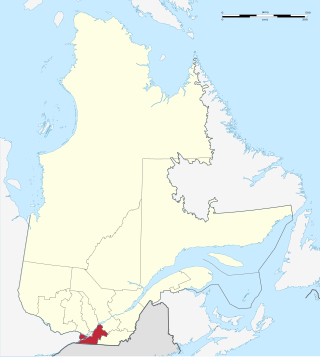
Saguenay is a city in the Saguenay–Lac-Saint-Jean region of Quebec, Canada, on the Saguenay River, about 200 kilometres (120 mi) north of Quebec City by overland route. It is about 126 kilometres (78 mi) upriver and northwest of Tadoussac, located at the confluence with the St. Lawrence River. It was formed in 2002 by merging the cities of Chicoutimi and Jonquière and the town of La Baie. Chicoutimi was founded by French colonists in 1676. As of July 2021, the city had a population of 145,000 and the metropolitan area had a population of 165,000.

Saint-Jean-sur-Richelieu is a city in eastern Montérégie in the Canadian province of Quebec, about 40 kilometres (25 mi) southeast of Montreal, located roughly halfway between Montreal and the Canada–United States border with the state of Vermont. It is situated on both the west and east banks of the Richelieu River at the northernmost navigable point of Lake Champlain. As of December 2019, the population of Saint-Jean-sur-Richelieu was 98,036.

The Richelieu River is a river of Quebec, Canada, and a major right-bank tributary of the St. Lawrence River. It rises at Lake Champlain, from which it flows northward through Quebec and empties into the St. Lawrence. It was formerly known by the French as the Iroquois River and the Chambly River, and was named for Cardinal Richelieu, the powerful minister under Louis XIII.

Saint-Hyacinthe is a city in southwestern Quebec east of Montreal on the Yamaska River. The population as of the 2021 Canadian census was 57,239. The city is located in Les Maskoutains Regional County Municipality of the Montérégie region, and is traversed by the Yamaska River. Quebec Autoroute 20 runs perpendicular to the river. Saint-Hyacinthe is the seat of the judicial district of the same name.

La Vallée-du-Richelieu(The Valley of the Richelieu) is a regional county municipality in the Montérégie region in southwestern Quebec, Canada. Its seat is McMasterville.

Chambly is an off-island suburb of Montreal in southwestern Quebec, Canada. It is located in the Montérégie region, inland from the South Shore of the Saint Lawrence River.

Beloeil is a city in Quebec, Canada. It is a suburb of Montreal, on the South Shore and is on the Richelieu River, 32 kilometres (20 mi) east of Montreal. According to the official Commission de toponymie du Québec, the name is written Belœil with an oe ligature; however, other sources avoid the ligature, including the Ministry of Municipal Affairs and the town's own official website.

La Prairie is an off-island suburb of Montreal, in southwestern Quebec, Canada, at the confluence of the Saint-Jacques River and the Saint Lawrence River in the Regional County Municipality of Roussillon. The population as of the Canada 2021 Census was 26,406.

The Royal Military College Saint-Jean, commonly referred to as RMC Saint-Jean and CMR, is a Canadian military college and university. It is located on the historical site of Fort Saint-Jean, in Saint-Jean-sur-Richelieu, Quebec, 40 km south of Montreal. RMC Saint-Jean is an arm of the Canadian Military College (CMC) system that provides two college-level programs in Social Science and Science, which are closely integrated with the undergraduate programs offered by the Royal Military College of Canada. RMC Saint-Jean was granted independent university status in 2021, and it currently offers a bachelor's degree in International Studies.

Montérégie is an administrative region in the southwest part of Quebec. It includes the cities of Boucherville, Brossard, Châteauguay, Longueuil, Saint-Hyacinthe, Saint-Jean-sur-Richelieu, Salaberry-de-Valleyfield and Vaudreuil-Dorion.

The Gatineau Hot Air Balloon Festival is an annual festival held in Gatineau, Quebec, Canada, and organized by a not-for-profit organization, during which hot air balloons of every shape and colour are flown and where 300 shows and performances adding up to over 60 hours’ worth of programming are taking place. More than 200,000 visitors and 1,000 RVs usually participate. It is held over four days in late-August and early September during the Labor Day Weekend.
Saint-Jean Airport is located in the southwestern section of the city of Saint-Jean-sur-Richelieu, Quebec, Canada. The airport handles general aviation traffic and is also the main site of the annual International Balloon Festival of Saint-Jean-sur-Richelieu. Summer also sees a major increase in the number of movements due to the Royal Canadian Air Cadets glider center held at the airport.
Autoroute 35 (A-35) is an Autoroute in the region of Montérégie, Quebec, Canada. With the first section constructed in the 1960s, the A-35 links Saint-Jean-sur-Richelieu with Montreal via the A-10. The A-35 is also the primary route for traffic between Montreal and Boston, although it ends 13.4 km (8.3 mi) short of the U.S. border. South of its current terminus in Saint-Sébastien, the A-35 continues as two-lane Route 133 to the border. An extension of A-35 to meet Interstate 89 at Saint-Armand will complete a nearly 500 km (310 mi) limited-access highway link between Montreal and Boston. It had been scheduled to open in 2017, but was delayed until 2023, and then delayed again until 2026.

Route 133 is a historic and heritage road of the Estrie and Montérégie regions in the province of Quebec, with north–south orientation and located on the eastern shore of the Richelieu River. Its northern terminus is in Sorel-Tracy, on the south shore of the Saint Lawrence River. The southern terminus is in Saint-Armand at the United States border with Vermont, close to Highgate Springs, where it continues southward past the Highgate Springs–St. Armand/Philipsburg Border Crossing as Interstate 89. Prior to the 1970s, the portion between the international border and Saint-Jean-sur-Richelieu was known as Route 7, which served as a continuation of US 7.

Montreal is the largest city in the province of Quebec, the second-largest in Canada, and the tenth-largest in North America. Founded in 1642 as Ville-Marie, or "City of Mary", it is now named after Mount Royal, the triple-peaked mountain around which the early settlement was built. The city is centred on the Island of Montreal and a few, much smaller, peripheral islands, the largest of which is Île Bizard. The city is 196 km (122 mi) east of the national capital, Ottawa, and 258 km (160 mi) southwest of the provincial capital, Quebec City.

Terminus Centre-Ville is a bus terminus located within 1000 de La Gauchetière in Montreal, Quebec, Canada. It is multimodal with the Bonaventure Metro station and Lucien-L'Allier Metro station on the Orange Line, and the Central Station in the city's downtown core. The terminus has 21 gates in three areas.

Saint-Blaise-sur-Richelieu is a municipality in the Canadian province of Quebec. The population as of the Canada 2016 Census was 2,066. The town was founded in 1892.

Saint-Jean-sur-Richelieu public transit is operated on behalf of the city of Saint-Jean-sur-Richelieu in the province of Quebec, Canada. The city lies on the Richelieu River about 50 kilometres (31 mi) southeast of Montreal, and is the regional capital of Haut-Richelieu Regional County Municipality. Gestrans is the contracted manager of the transportation system with the buses for both local and commuter services being operated by Transdev.

Fort Saint-Jean is a fort in the Canadian province of Quebec located on the Richelieu River. The fort was first built in 1666 by soldiers of the Carignan-Salières Regiment of France who had travelled to New France to assist the young colony. It was part of a series of forts built along the Richelieu River. Over the years, it was destroyed and rebuilt several times, but it is, after Quebec City, the military site that has been occupied non-stop for the longest time in Canada. The fort is designated as a National Historic Site of Canada, and it currently houses the Royal Military College Saint-Jean. The fort has been continually occupied since 1748, and is the core from which the city of Saint-Jean-sur-Richelieu, Quebec grew around. Fort Saint-Jean played a crucial role in the British defense strategy during the 1775 American invasion of the Province of Quebec.

















